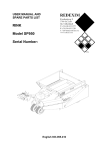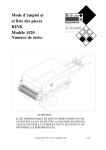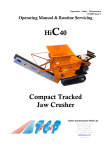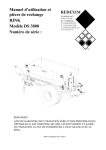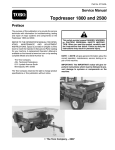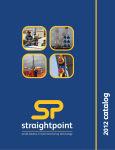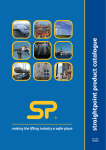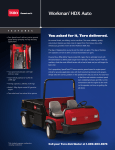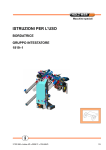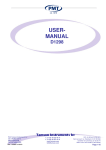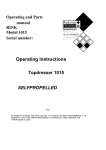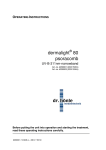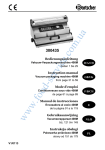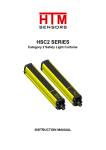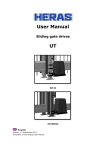Download RINK Model 1622 Series number:
Transcript
OPERATION MANUAL AND LIST OF PARTS RINK Model 1622 Series number: WARNING: IN ORDER TO ENSURE SAFE USE OF THE MACHINE AND OPTIMAL RESULTS, IT IS ESSENTIAL TO READ THIS OPERATION MANUAL CAREFULLY BEFORE BEGINNING TO OPERATE THIS RINK MACHINE. 1325 English 933.120.420 EC – DECLARATION OF CONFORMITY Manufacturers (or importer’s) Certificate of Compliance for RINK Topdresser1622 The undersigned, Rink Spezialmaschinen GmbH 88279 Amtzell Deutschland/Germany hereby declares that the machine specified below complies with all relevant provisions of the Machinery Directive (2006/42/EC). 1. Machine name: RINK Topdresser 1622 2. Manufacturer or importer: Rink Spezialmaschinen GmbH Wangenerstraße 20 88279 Amtzell 3. Model: 1622 4. Machine/ Series number: 5. Year of manufacture: Amtzell, (date) -2- Uli Bachmann 1622 TABLE OF CONTENTS EC - DECLARATION OF CONFORMITY ......................................................................... 2 SAFETY REGULATIONS...................................................................................................4-5 BRIEF DESCRIPTION........................................................................................................... 6 TECHNICAL SPECIFICATIONS......................................................................................... 6 FIRST TIME USE.................................................................................................................... 7 OPERATION............................................................................................................................ 8 Before each use ................................................................................................................................................... 8 Attachment and detachment................................................................................................................................ 8 Loading ............................................................................................................................................................... 8 SCATTERING ......................................................................................................................... 9 Operating controls............................................................................................................................................... 9 Set scattering thickness ....................................................................................................................................... 9 CARE and MAINTENANCE ............................................................................................... 10 Lubricate bearings with all-purpose grease (after every 50 hours of use)......................................................... 10 Change oil in conveyor-belt transmission (after every 100 hours of use)......................................................... 11 Service axle (after every 100 hours of use)....................................................................................................... 12 Set brush roller spacing (as required)................................................................................................................ 13 Tension conveyor belt (if slipping) ................................................................................................................... 14 Installing and removing conveyor belt.............................................................................................................. 16 Tension conveyor belt after installing............................................................................................................... 16 External oil supply# ........................................................................................................................................... 18 REPLACEMENT PARTS..................................................................................................... 20 Address for ordering replacement parts ............................................................................................................ 20 RINK Topdresser 1622 complete............................................................... Fout! Bladwijzer niet gedefinieerd. Belt component complete........................................................................... Fout! Bladwijzer niet gedefinieerd. Scattering roller complete .......................................................................... Fout! Bladwijzer niet gedefinieerd. Technical alterations reserved. 1622 -3- SAFETY REGULATIONS The RINK Topdresser 1622 is built exclusively for spreading fine-grain and loose scattering materials such as sand, gravel, granules and similar materials. Any other usage is considered to be improper. The manufacturer is not liable for any damages incurred as a result; the user alone carries the responsibility for the risk involved. The intended use also includes compliance with the manufacturer’s specified operating, maintenance and repair requirements. The RINK Topdresser 1622 is built in accordance with the latest technological specifications and is safe to operate. However, RINK Topdresser 1622 can present a danger to life and limb to the user and others if it is operated, serviced and/or repaired by any persons who are not familiar with the safety regulations and have not been made aware of the dangers involved. Every person who has been commissioned by the user to operate, service and repair the spreader must have read and understood the user manual and in particular, the section: Safety Regulations. Only the Manufacturer’s original replacement parts must be used for repairs. As well as the instructions in this operation manual, the generally applicable Safety and accidentprevention regulations are to be observed. When using public roads, the respective provisions (road traffic regulations) apply. The transportation of persons is not permitted! Stepping onto the loading bridge whilst the spreading equipment is running is prohibited. A corresponding notice has been stuck onto each side of the RINK Topdresser 1622. These notices must be legible at all times and must be replaced if they become damaged. The operator is obliged to inspect the RINK Topdresser 1622 before using it for visible signs of damage and defects. Alterations in the RINK Topdresser 1622 - including its operation - which could have adverse effects on its safe operation must be rectified immediately. For safety reasons, it is expressly prohibited to make alterations or additions to the RINK Topdresser 1622. If any modifications to the RINK Topdresser 1622 are undertaken, then the CE-mark that is valid for the machine becomes invalid and must be independently renewed by the person who has made such modifications. -4- 1622 SAFETY REGULATIONS The permissible vertical load of the towing vehicle must be observed. Before starting the engine, check the immediate surroundings and ensure adequate visibility. During operation, no persons should be within the danger zone of the spreader, as there is a risk of injury from rotating parts and flying debris. Pay attention to suitable clothing. Wear safety shoes and full-length trousers. Long hair must be tied back. Do not wear loose items of clothing. Use appropriate personal protective equipment in accordance with applicable health and safety regulations. The RINK Topdresser 1622 produces a noise level of 74 dB (a) in the immediate vicinity of the brush roller. Wear certified hearing protection when working with the machine. Adjustment and repair work may only be carried out by authorised personnel. Before beginning repair work on the hydraulic equipment ensure without fail that it has been depressurised. Inspect hydraulic hoses regularly and replace them if you find defects or alterations. Hydraulic hoses must meet the technical requirements of the equipment manufacturer. Spent oil endangers the environment; please dispose of it in an environmentally sound manner. 1622 -5- BRIEF DESCRIPTION The RINK Topdresser 1622 is designed for spreading fine-grain and loose scattering materials such as sand, gravel, granules and similar materials The topdresser’s diffuser is driven by a gearbox with a hydraulic motor for the conveyor belt and a hydraulic motor for the brush roller. The rotational speed of the hydraulic motor for the conveyor is infinitely variable via a flow regulator. This allows the scattering material to be dosed accurately. The scattering density or spread rate can be determined by driving speed, the rotational speed of the brush roller and the conveyor belt speed. TECHNICAL SPECIFICATIONS Dimensions Length................................................................................... 2.70 m Width .................................................................................... 2.30 m Height ................................................................................... 1.95 m Bridge size ................................................................................ 1.85 x 2.01 m Load .......................................................................................... max. 2.50 m3 Weights Permissible total weight ...................................................... 4500 kg Permissible axle load............................................................ 4000 kg Permissible vertical load....................................................... 500 kg Empty weight ................................................................... ... 1000 kg Track gauge.............................................................................. 1360 mm Tyres ......................................................................................... 520/50-17RibTrailor Tyre pressure ........................................................................... 2.0 bar Permissible max. speed............................................................ 25 km/h Tractor power .......................................................................... min. 26 KW (35 PS) Spread rate ............................................................................... infinitely variable Hydraulic connection values Minimum flow, towing vehicle ............................................ 25 l/min Minimum pressure, towing vehicle ...................................... 140 bar The identification plate is located on the front of the spreader on the right-hand side. -6- 1622 FIRST TME USE - Tighten wheel nuts. - Check wheel hub clearance and adjust if necessary. - Check tyre pressure. Inspect these items again after the first run under load! 1622 -7- OPERATION Before each use - Inspect the RINK Topdresser 1622 for visible defects. Rectify defects. - Check tyre pressure. - Inspect the running track of the conveyor belt and adjust where necessary. The conveyor belt must not touch the sides. Attachment and detachment - Secure the RINK Topdresser 1622 in standing position with wedges to prevent it from rolling. - Attach the RINK Topdresser 1622 to the towing vehicle. - Establish hydraulic connection: the pressure pipe is lying on the right in the direction of travel, the return pipe is lying on the left in the direction of travel. Oil circulation is required. On leaving the factory, the hydraulic system is filled with the hydraulic oil, Plantosyn 3268 ECO. - For external oil supply # (see page 15) insert the attachment pump into the PTO shaft on the tractor and secure it against rotation using the integrated torque arm. The PTO must be turned on only at idle, since the activation of the PTO-run under load can cause a fracture of the connection pinion between the transmission and the pump. For optimal operation, the PTO speed should be approximately 450 1/min, corresponding to 25 l / min. The oil temperature at the start of work should be about 25 oC (sight glass on the oil tank) or if necessary, allow the hydraulic system to warm up. PTO speed or oil temperature that is too low will impair scattering performance. Check oil level on the hydraulic tank (centre in sight glass) before starting work. On leaving the factory, the hydraulic system is filled with the hydraulic oil, Plantosyn ECO 3268. Too little oil can cause damage to or destruction of the hydraulic pump. - Crank up the support wheel, lifting the safety flap. Lay the hydraulic pumps such that they do not scrape the ground or rub against the towing vehicle. Detach in reverse order! Before detaching, depressurise the hydraulic system on the towing vehicle. Loading - Attend to the desired maximum ground pressure (see Technical specifications). - When loading, pay attention to the permissible total weight. Ensure uniform loading. - -8- 1622 SCATTERING Operating controls The brush roll speed can only be regulated by adjusting the tractor rpm. (1) Regulator for adjusting the conveyor belt speed on a scale of 0 to 10 Set scattering thickness The scattering thickness is dependent upon: - the speed of the towing vehicle - the speed of the brush roller (tractor rpm.) - the speed of the controller for the conveyor belt (1). 1622 -9- CARE and MAINTENANCE Grease the bearings with all-purpose grease (after every 50 hours of use) (1) Bearings on both sides of the brush roller (2) Bearings on both sides of the rear transport shaft (3) Bearings on both sides of the front transport shaft Bearings without grease nipples are maintenance-free. - 10 - 1622 Change oil on conveyor-belt gears (after every 100 hours of use) - Unscrew the filler plug (1). - Release the draining plug (2) on the inside at the bottom and drain the oil away. - Screw the draining plug back into place. - Fill with gear oil, EP140 up to the check screw (3). - Screw the filler plug back into place. Spent oil endangers the environment; please dispose of it in an environmentally sound manner. 1622 - 11 - Service axle (after every 100 hours of use) Servicing work on the axle must only be carried out by authorised specialist personnel. - Tighten wheel nuts. - Check the wheel hub clearance and adjust if necessary. - Check the brake setting. - Check the brake pad thickness (min. 3mm) and get the brake pads renewed if necessary. - 12 - 1622 Set the brush roller distance (when required) - Release the two screws (1) on both sides of the brush roller. - Lower the brush roller until it slightly touches the conveyor belt. - Secure the screws (1) back into place 1 1622 - 13 - Tension the conveyor belt (if slipping) - Release the locking nut (1) on each side. - Gradually tighten the nuts (2) by ½ turns on each side at a time in a clockwise direction. - Secure the locking nut (1) on each side back into place. Over tensioning shortens the service life of the conveyor belt! - 14 - 1622 1622 - 15 - Installing and removing the conveyor belt - Relax the conveyor belt by releasing the tension screw (1) gradually and evenly on each side. - Remove the belt transmission by releasing the screw (6) on the front end. - Remove the eccentric ring (8) on the flange bolt (9) on each side and unscrew the flange bolt on each side. - Remove the eccentric bearing (11) on the flange bolt (12) on each side. - Remove the flange bolt (12) with the tension screw (1) on the right-hand side. - Release the screws (10) on the right side and remove the intermediate roller bearing (3). - Release the screws (10) on the left side. - Remove the front (2) and rear belt rollers (5) and the intermediate rollers (4). - Pull the conveyor belt out towards to the rear. Installation is carried out by the same steps in reverse order. Tension the conveyor belt after installing - With the conveyor belt relaxed, mark a length of 500 mm on the conveyor belt on both sides. - Tension the conveyor belt on both sides evenly using the two tension screws (see page 13) until the marked length is stretched to a maximum of 502 mm. - Allow the conveyor belt to run for 30 mins. until it runs centrally between the side guides, adjusting it if necessary. - 16 - 1622 The conveyor belt must not touch the side guides as this will damage it. During readjustment, gradually adjust the conveyor belt tension on the side on which it is touching the side guides. Over tensioning shortens the service life of the conveyor belt! 1622 - 17 - External oil supply # Change oil in the attachment pump (after every 100 hours of use) - Unscrew the vent screws (1). - Loosen the draining plug (2) at the bottom and drain the oil away. - Screw the filler plug back into place using a new seal. - Rotate the gear by 180 degrees. - Fill with oil SAE 120 to 140 up to the level of the sight glass (3). - Screw the draining plug (2) back into place using a new seal. Spent oil endangers the environment; please dispose of it in an environmentally sound manner. 1 / Art. no.: 16057-1 2 / Art.no.: 16057-2 7 1 6 4 3 / Art. no.: 16057-3 4 / Art. no.: 16057-4 5 / Art. no.: 10842 6 / Art. no.: 10840 7 / Art. no.: 10722 5 3 2 - 18 - 1622 Change oil in hydraulic tank (when required) - Unscrew the filler plug (6). - Release the hose (4) and drain the oil away. - Screw the hose back into place. - Fill with Plantosyn 3268 ECO up to the centre in the sight glass (5). - Screw the filler plug (6) back into place. This is a closed hydraulic circuit. To prevent impurities from entering even so, the return filter (7) must be replaced after 100 hours of use. Spent oil endangers the environment; please dispose of it in an environmentally sound manner. 1622 - 19 - REPLACEMENT PARTS RINK Topdresser 1622 Address for ordering replacement parts Fout! Verwijzingsbron niet gevonden. Ordering replacement parts So that your order for replacement parts can be processed swiftly, it is essential for the following information to accompany every order: - Chassis number or identification number - Year of manufacture (if available) - Parts numbers, from the relevant replacement parts list - Name of part/s - Order no. Example order: 529413 Chassis no. - 20 - 2012 27 Year of manufacture Pillow block bearing 25 mm Parts no. Name 10133 Order no. 1622





















